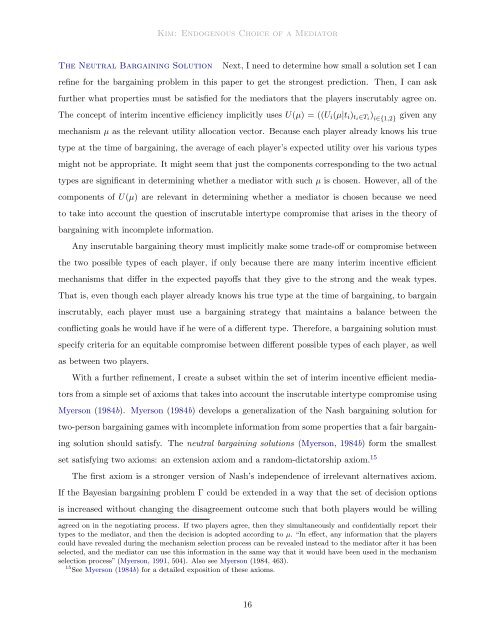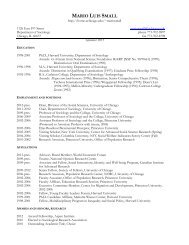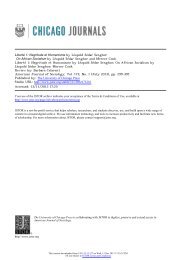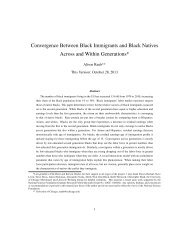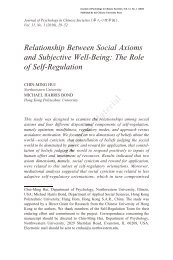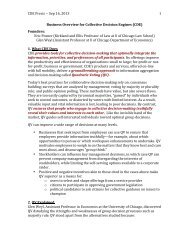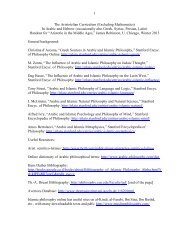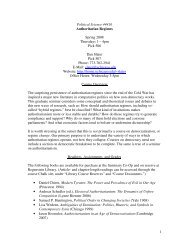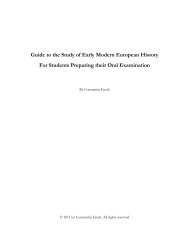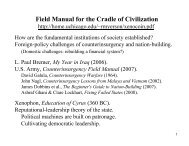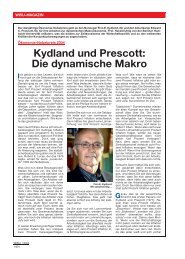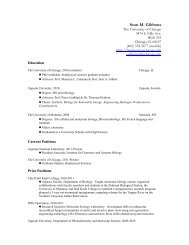Job Market Paper - Personal Web Pages - University of Chicago
Job Market Paper - Personal Web Pages - University of Chicago
Job Market Paper - Personal Web Pages - University of Chicago
Create successful ePaper yourself
Turn your PDF publications into a flip-book with our unique Google optimized e-Paper software.
Kim: Endogenous Choice <strong>of</strong> a Mediator<br />
The Neutral Bargaining Solution<br />
Next, I need to determine how small a solution set I can<br />
refine for the bargaining problem in this paper to get the strongest prediction. Then, I can ask<br />
further what properties must be satisfied for the mediators that the players inscrutably agree on.<br />
The concept <strong>of</strong> interim incentive efficiency implicitly uses U(µ) = ((U i (µ|t i ) ti ∈T i<br />
) i∈{1,2}<br />
given any<br />
mechanism µ as the relevant utility allocation vector. Because each player already knows his true<br />
type at the time <strong>of</strong> bargaining, the average <strong>of</strong> each player’s expected utility over his various types<br />
might not be appropriate. It might seem that just the components corresponding to the two actual<br />
types are significant in determining whether a mediator with such µ is chosen. However, all <strong>of</strong> the<br />
components <strong>of</strong> U(µ) are relevant in determining whether a mediator is chosen because we need<br />
to take into account the question <strong>of</strong> inscrutable intertype compromise that arises in the theory <strong>of</strong><br />
bargaining with incomplete information.<br />
Any inscrutable bargaining theory must implicitly make some trade-<strong>of</strong>f or compromise between<br />
the two possible types <strong>of</strong> each player, if only because there are many interim incentive efficient<br />
mechanisms that differ in the expected pay<strong>of</strong>fs that they give to the strong and the weak types.<br />
That is, even though each player already knows his true type at the time <strong>of</strong> bargaining, to bargain<br />
inscrutably, each player must use a bargaining strategy that maintains a balance between the<br />
conflicting goals he would have if he were <strong>of</strong> a different type. Therefore, a bargaining solution must<br />
specify criteria for an equitable compromise between different possible types <strong>of</strong> each player, as well<br />
as between two players.<br />
With a further refinement, I create a subset within the set <strong>of</strong> interim incentive efficient mediators<br />
from a simple set <strong>of</strong> axioms that takes into account the inscrutable intertype compromise using<br />
Myerson (1984b). Myerson (1984b) develops a generalization <strong>of</strong> the Nash bargaining solution for<br />
two-person bargaining games with incomplete information from some properties that a fair bargaining<br />
solution should satisfy. The neutral bargaining solutions (Myerson, 1984b) form the smallest<br />
set satisfying two axioms: an extension axiom and a random-dictatorship axiom. 15<br />
The first axiom is a stronger version <strong>of</strong> Nash’s independence <strong>of</strong> irrelevant alternatives axiom.<br />
If the Bayesian bargaining problem Γ could be extended in a way that the set <strong>of</strong> decision options<br />
is increased without changing the disagreement outcome such that both players would be willing<br />
agreed on in the negotiating process. If two players agree, then they simultaneously and confidentially report their<br />
types to the mediator, and then the decision is adopted according to µ. “In effect, any information that the players<br />
could have revealed during the mechanism selection process can be revealed instead to the mediator after it has been<br />
selected, and the mediator can use this information in the same way that it would have been used in the mechanism<br />
selection process” (Myerson, 1991, 504). Also see Myerson (1984, 463).<br />
15 See Myerson (1984b) for a detailed exposition <strong>of</strong> these axioms.<br />
16


